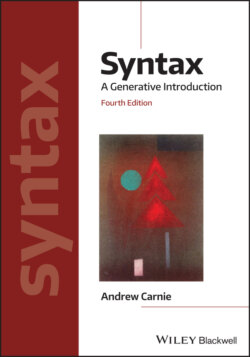Читать книгу Syntax - Andrew Carnie - Страница 22
Statistical Probability or UG?
ОглавлениеIn looking at the logical problem of language acquisition you might be asking yourself, “Ok, so maybe kids don’t get all the data, but perhaps they get enough to draw conclusions about what is the most likely structure of their grammar?” For example, we might conclude that a child learning English would observe the total absence of any sentences that have that followed by a trace (e.g., 28d), so after hearing some threshold of sentences they conclude that this sentence type is ungrammatical. This is a common objection to the hypothesis of UG. Unfortunately, this hypothesis can’t explain why many sentence types that are extremely rare (to the point that they are probably never heard by children) are still judged as grammatical by the children. For example, English speakers rarely (if ever) produce sentences with seven embeddings (John said that Mary thinks that Susan believes that Matt exclaimed that Marian claimed that Art said that Andrew wondered if Gwen had lost her pen); yet speakers of English routinely agree these are acceptable. The actual speech of adult speakers is riddled with errors (due to all sorts of external factors: memory, slips of the tongue, tiredness, distraction, etc.). However, children do not seem to assume that any of these errors, which they hear frequently, are part of the data that determine their grammars.
6.5 Explaining Language Variation
The evidence for UG seems to be very strong. However, we are still left with the annoying problem that languages differ from one another. This problem is what makes the study of syntax so interesting. It is also not an unsolvable one.
The fact that an inborn system should allow variation won’t be a surprise to any biologist. Think about the color of your eyes. Every sighted person has eyes. Having eyes is clearly an inborn property of being a human (or being a mammal). I doubt that anyone would object to that characterization. Nevertheless we see both widespread variation in eye color, size, and shape among humans, and widespread variation in form and position among various mammalian species. A closer analog to language might be bird song. In 1962, Marler and Tamura observed dialect variation among the songs of white-crowned sparrows. The ability and motivation for these birds to vocalize is widely assumed to be innate, but the particular song they sing is dependent upon the input they hear.
One way in which languages differ is in terms of the words used in the language. The different words of different languages clearly have to be learned or memorized and are not innate. Other differences between languages must also be acquired. For example the child learning English must determine that its word order is subject-verb-object (SVO), but the child learning Irish determines the order is verb-subject-object (VSO) and the Turkish child figures out subject-object-verb (SOV) order. The explanation for this kind of fact will be explored in more detail in chapter 6. Foreshadowing slightly, we’ll claim there that differences in the grammars of languages can be boiled down to the setting of certain innate parameters (or switches) that select among possible variants. Language variation thus reduces to learning the correct set of words and selecting from a predetermined set of options.
Oversimplifying slightly, most languages put the elements in a sentence in one of the following word orders:
| 31) a) | Subject Verb Object (SVO) | (e.g., English) |
| b) | Subject Object Verb (SOV) | (e.g., Turkish) |
| c) | Verb Subject Object (VSO) | (e.g., Irish) |
A few languages use
d) Verb Object Subject (VOS) (e.g., Malagasy)
No (or almost no13) languages use
e) Object Subject Verb (OSV)
f) Object Verb Subject (OVS)
Let us imagine that part of UG is a parameter that determines the basic word order. Four of the options (SVO, SOV, VSO, and VOS) are innately available as possible settings. Two of the possible word orders are not part of UG. The child who is acquiring English is innately biased towards one of the common orders; when she hears a sentence like “Mommy loves Kirsten”, if the child knows the meaning of each of the words then she might hypothesize two possible word orders for English: SVO and OVS. None of the others are consistent with the data. The child thus rejects all the other hypotheses. OVS is not allowed, since it isn’t one of the innately available forms. This leaves SVO, which is the correct order for English. So children acquiring English will choose to set the word order parameter at the innately available SVO setting.
In his excellent book The Atoms of Language, Mark Baker inventories a set of possible parameters of language variation within the UG hypothesis. This is an excellent and highly accessible treatment of parameters. I strongly recommend this book for further reading on how language variation is consistent with Universal Grammar.
You now have enough information to try GPS7, GPS8, and CPS 11.
